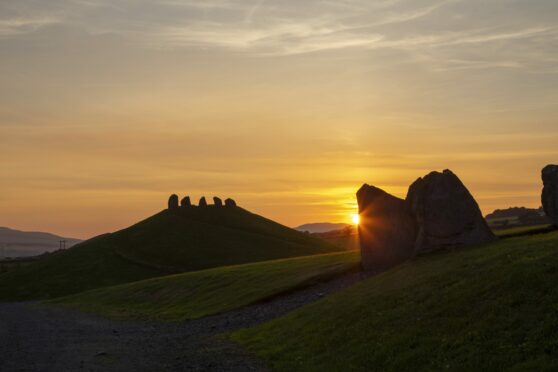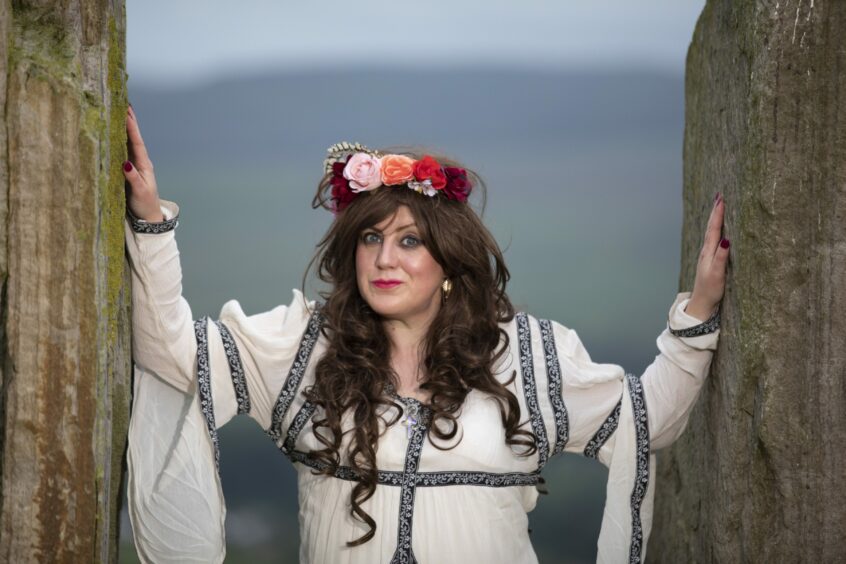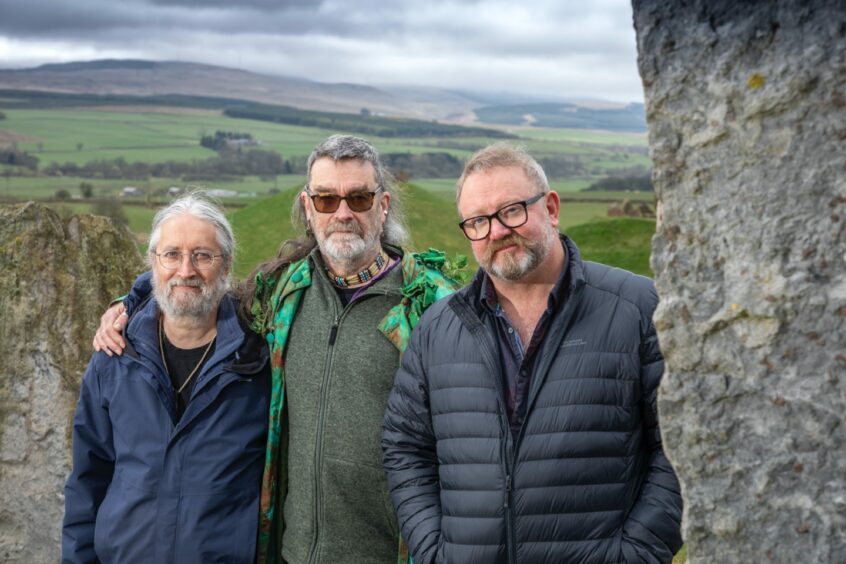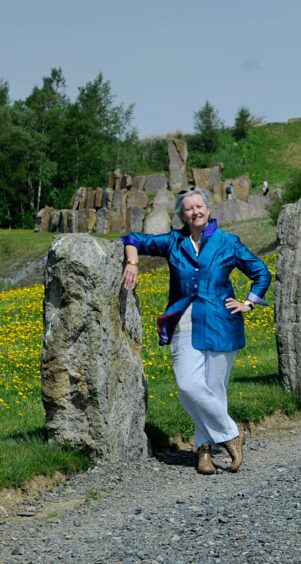
The yellowing, arid land that was once our lawns and the red rawness of our previously pasty skin might suggest it has already been here for weeks, but summer officially arrives on Wednesday.
The summer solstice – or the longest day – will see the sun at its yearly highest point in the sky, and for centuries this moment has been celebrated by cultures around the world.
Over the past few weeks, many Scottish blokes have shown their appreciation for the sun by baring their bellies towards the unusually bright blob in the sky.
But, at Crawick Multiverse, the cosmos-inspired artland in Dumfries and Galloway, the celebrations this week will take on a more traditional and spiritual form.
A week-long series of events beginning today will peak with two ceremonies on June 21 – a sunrise ceremony in the early hours, and a tilt ceremony at 3.57pm, when the sun is at its highest.
We speak to four people involved in the celebrations, who explain why the summer solstice remains so special and why Crawick Multiverse is a modern-day contender to Stonehenge’s otherworldly crown.
Andrea Thompson
Every year, Andrea Thompson promises she will use the longest day to reflect and look at what she has achieved, so when Crawick announced its solstice celebrations in 2022, she decided it was the perfect opportunity to go all in.
“I’m a part-time actor and full-time fancy dress-up who’s inspired by Kate Bush and the pre-Raphaelites, so I decided the solstice was the perfect excuse,” she said. “I’m not a pagan or a druid but I wanted to look the part, so I dressed up and hoped the genuine pagan people didn’t think I was being cheeky.
“A couple embraced me and talked me through the rituals as the sun was rising. I felt such a warm welcome, and there were other people who were there who weren’t pagans.
“It was a money-can’t-buy experience and I think everyone should have it on their bucket list to be at this otherworldly site to see the sunrise on the longest day of the year.”
While there is no accounting for the Scottish weather putting a dampener on events, for Andrea, a magazine editor from the rural Dumfries and Galloway village of Holywood, everything else about the experience was perfect.
“I think I expected a very dramatic sun appearing in the sky like a golden orb, but it didn’t quite happen like that – it was dreich and drizzling, so it wasn’t like someone flicking a switch,” she said. “The reality of the Scottish climate meant it didn’t work out like that, but everything else about it exceeded expectations.
“I felt energised, despite having got up at 2.30am, and I’ll be back again this year – with a different outfit!”
Stephen Peake
If you’ve never heard of a tilt ceremony, worry not…few have.
Stephen Peake has the distinction of leading the proceedings at Crawick on Wednesday, and he is fairly confident it will be a first for Scotland, if not further afield.
“I’m not aware in our modern, Western culture that we have anything like a tilt ceremony,” said the professor of climate change and energy at The Open University. “We are creating the ceremony – it’s not written down.
“The tilt is the single moment when the axis of the Earth is tilting at its maximum towards the sun. It’s a singular second in the year, experienced by everyone at the same time.”
Peake hopes the ceremony provides another outlet to discuss the climate and energy emergency facing the world.
“As professor of climate change and energy, I have a particular angle on the world right now,” he said. “My job is to communicate to mass audiences the predicament we are in, which is we need to wean ourselves from fossilised sunlight and live off available sunlight. There’s more than enough, even in Scotland in winter, when you consider wind is solar energy, too.
“I want to reinstate a different idea of the relationship with the solstice, to help us recognise the power of the sun in our lives. The Earth’s wind systems, the ocean currents, the energy the plants absorb, the food we eat – all related to the sun and we should take a moment to reflect on that. I think this ceremony opens another channel to talk.”
Graham Harvey
The constant cycle of doom-mongering news about the climate is, Graham Harvey concedes, perhaps not conducive to providing motivation for positive change. He hopes by literally shining a light on the subject it will help encourage people to take action.
“Given the danger of mass extinction and climate change, one of the big issues is getting people motivated,” said the emeritus professor of religious studies at The Open University.
He will conduct the solstice celebrations at Crawick, where the sun will rise at 4.33am on Wednesday, alongside professional storyteller Gordon MacLellan.
“We always hear disaster stories, which depress people, and you end up doing nothing because it feels so big, or you beat yourself up because you feel you don’t do enough,” said Harvey. “But if we celebrate something like the solstice and enjoy it, then it might motivate us to do more activist and dramatic things. The point of the ceremony is to celebrate the fact life exists here only because the sun and the Earth and the moon are in a particular relationship.”
Harvey has attended solstice events in cultures around the world, but this will be his first marking it at Crawick. He said: “It’s a great site. I was brought up near Stonehenge, so I used to hang out there with the hippies. Then I got more into it, personally and for research.”
Regarding the centuries-old tradition of celebrating the solstice, he said: “There’s the sense it’s very ordinary but still has something special about it. There’s a fusion between the ordinariness and specialness. It’s a time when a lot of cultures say thank-you and ask what they can do to encourage this to continue.”
Gillian Khosla
“It seems natural that our unique selling point be the solstice, and maybe in time we can become the Stonehenge of Scotland,” said Gillian Khosla, who has been the chairwoman of the Crawick Multiverse board for the past five years.
The late American architect designer Charles Jencks transformed the former open cast mine into a 55-acre attraction inspired by his thoughts on space, astronomy and cosmology.
“We had our first solstice event in 2017, which was to celebrate what turned out to be Charles’ last installation,” said Khosla. “When you’re trying to work out a long-term future for an artland like this, which is unique and in a very lowly populated area, you need to be creative in thinking how we invite people to be part of this. The solstice feels like something for us to put our fingerprints on, to say ‘this is us’.”
Reacting to public interest, Crawick now has a licence to allow campervans on site, so people can stay there overnight in anticipation for the sun rising on Wednesday.
The collaboration with The Open University expands on Crawick’s links to the environment, climate, land and beyond – subjects the public is becoming increasingly interested in, and Crawick intends to take advantage. “As a society we seem to be more aware of equinoxes and those periods that mark time through the year,” she said.
“Look at the work of Brian Cox in enthusing people of what’s out there. It’s all moved into an area where those of us who aren’t astronomers feel more comfortable.
“The marking of time is important – in rural areas like this one, the marking of time seasonally is hugely important to the economy and livelihoods and the way everyone lives here.
“In the future, we hope to celebrate the winter solstice and the equinoxes at Crawick as well.”

Enjoy the convenience of having The Sunday Post delivered as a digital ePaper straight to your smartphone, tablet or computer.
Subscribe for only £5.49 a month and enjoy all the benefits of the printed paper as a digital replica.
Subscribe © MIKE BOLAM
© MIKE BOLAM © MIKE BOLAM
© MIKE BOLAM © Colin Hattersley
© Colin Hattersley